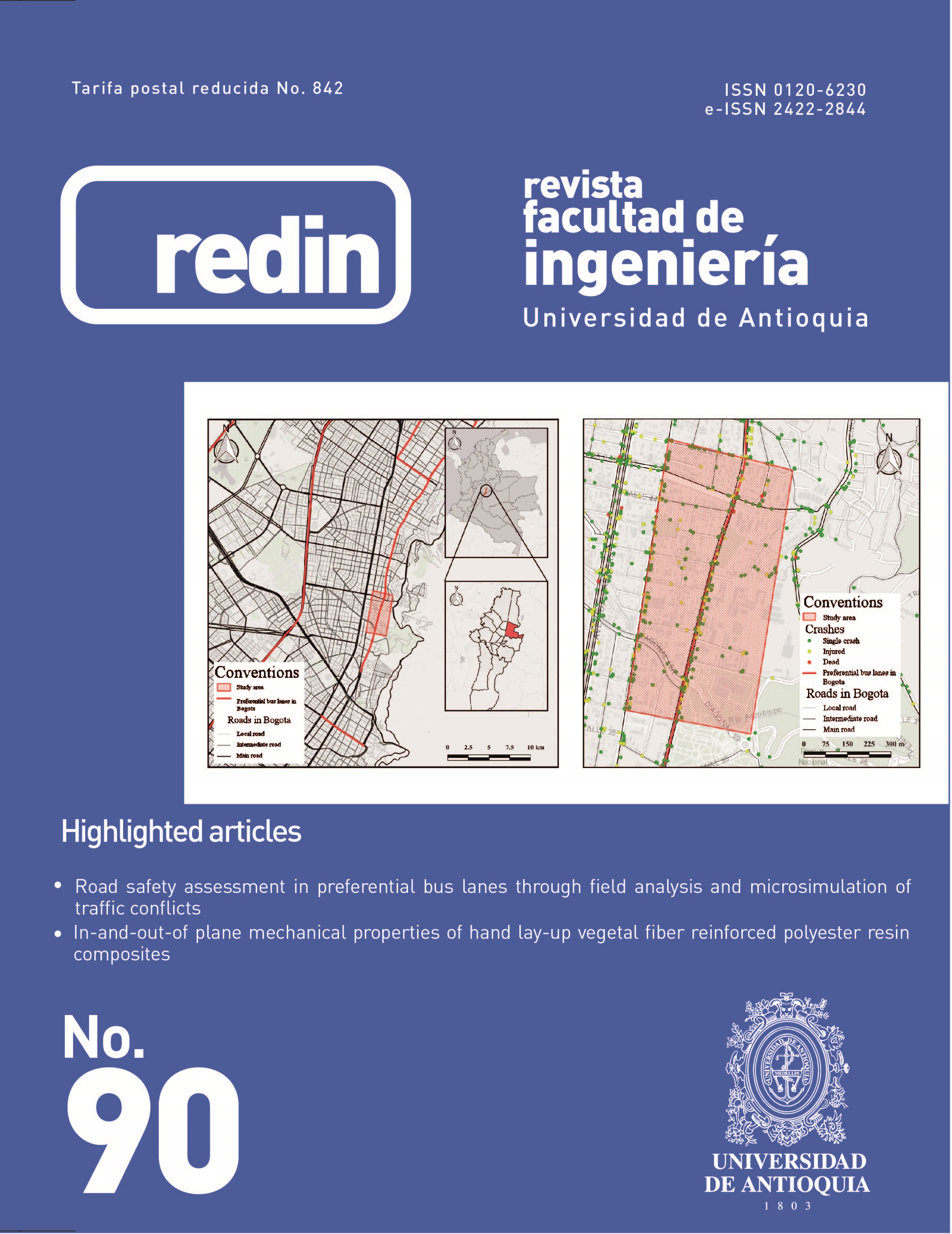Predicción del ruido proveniente de los aerogeneradores: estudio teórico y experimental
DOI:
https://doi.org/10.17533/udea.redin.n90a04Palabras clave:
ruido aerogeneradores, norma ISO 9613 Parte 2, propagación del ruidoResumen
Hay muchos modelos de propagación de ruido que se utilizan para calcular el ruido proveniente de los aerogeneradores. Sin embargo, fallan en la precisión con que pueden predecir los niveles de presión sonora. La mayoría de estos modelos han sido desarrollados para estimar el ruido proveniente de las industrias, con velocidades del viento inferiores a 5 m/s y condiciones favorables a su propagación. Hasta ahora hay muy pocos modelos que se puedan aplicar para la propagación del sonido proveniente de los aerogeneradores y la mayoría de ellos arrojan resultados poco precisos. En este artículo se presenta una comparación entre los niveles de ruido estimados a través del método de predicción establecido en la norma ISO 9613 Parte 2 y los niveles de ruido medidos proveniente de los aerogeneradores instalados en un parque eólico en funcionamiento. Se encontraron diferencias entre los niveles de presión sonora estimados y medidos de hasta 56.5 dBZ, con una mediana de 29.6 dBZ. El nivel de presión sonora residual arrojado por la norma ISO 9613 Parte 2 para los aerogeneradores es mayor para las frecuencias altas que para las frecuencias bajas.
Descargas
Citas
Attenuation of sound during propagation outdoors: General method of calculation, ISO 9613 Part 2, 1996.
P. J. Dickinson, “A pragmatic view of a wind turbine noise standard,” in Acoustics, Adelaide, Australia, 2009, pp. 1–8.
G. van den Berg, “The sound of high winds: The effect of atmospheric stability on wind turbine sound and microphone noise,” Ph.D. dissertation, University of Groningen, Groningen, Netherlands, 2006.
J. H. Bass, A. J. Bullmore, and E. Sloth, “Development of a wind farm noise propagation prediction model,” The European Commision, Brussels, Belgium, Tech. Rep., May 1998.
E. Pedersen, J. Forssén, and K. P. Waye, “Human perception of sound from wind turbines,” Swedish Environmental Protection Agency, Stockholm, Sweden, Tech. Rep. 6370, Jun. 2010.
M. Wondollek, “Sound from wind turbines in forest areas,” Uppsala Universitet, Uppsala, Sweden, Tech. Rep., Jan. 2009.
M. Friman, “Directivity of sound from wind turbines. a study on the horizontal sound radiation pattern from a wind turbine,” M.S. thesis, The Marcus Wallenberg Laboratory for Sound and Vibration Research, Stockholm, Sweden, 2011.
S. Hoogzaad, “Measuring and calculating turbine noise immission in the netherlands,” in Wind expert meeting sound propagation models, Stockholm, Sweden, 2009, pp. 1–18.
K. Kaliski, E. Duncan, D. K. Wilson, and S. Vecherin, “Improving predictions of wind turbine noise using pe modeling,” in 158th Meeting Acoustical Society of America/NOISE-CON, Portland, USA, 2011, pp. 1–13.
R. E. Walpole, R. H. Myers, and S. L. Myers, Probability and statistics for engineers, 6th ed. Naucalpan, Mexico: Prentice Hall, 1999.
B. Thorne, “The problems with ”noise numbers” for wind farm noise assessment,” Bulletin of Science Technology and Society, vol. 31, no. 4, pp. 1–262, Jul. 2011.
B. Martín and et al., “Acoustic impact of wind farms and their evolution,” in Acústica, Coimbra, Portugal, 2008, pp. 1–11.
H. Møller and C. S. Pedersen, “Low-frequency noise from large wind turbines,” Journal of the Acoustical Society of America, vol. 129, no. 6, pp. 3727–3744, Jun. 2011.
Descargas
Publicado
Cómo citar
Número
Sección
Licencia
Derechos de autor 2019 Revista Facultad de Ingeniería Universidad de Antioquia

Esta obra está bajo una licencia internacional Creative Commons Atribución-NoComercial-CompartirIgual 4.0.
Los artículos disponibles en la Revista Facultad de Ingeniería, Universidad de Antioquia están bajo la licencia Creative Commons Attribution BY-NC-SA 4.0.
Eres libre de:
Compartir — copiar y redistribuir el material en cualquier medio o formato
Adaptar : remezclar, transformar y construir sobre el material.
Bajo los siguientes términos:
Reconocimiento : debe otorgar el crédito correspondiente , proporcionar un enlace a la licencia e indicar si se realizaron cambios . Puede hacerlo de cualquier manera razonable, pero no de ninguna manera que sugiera que el licenciante lo respalda a usted o su uso.
No comercial : no puede utilizar el material con fines comerciales .
Compartir igual : si remezcla, transforma o construye a partir del material, debe distribuir sus contribuciones bajo la misma licencia que el original.
El material publicado por la revista puede ser distribuido, copiado y exhibido por terceros si se dan los respectivos créditos a la revista, sin ningún costo. No se puede obtener ningún beneficio comercial y las obras derivadas tienen que estar bajo los mismos términos de licencia que el trabajo original.










 Twitter
Twitter